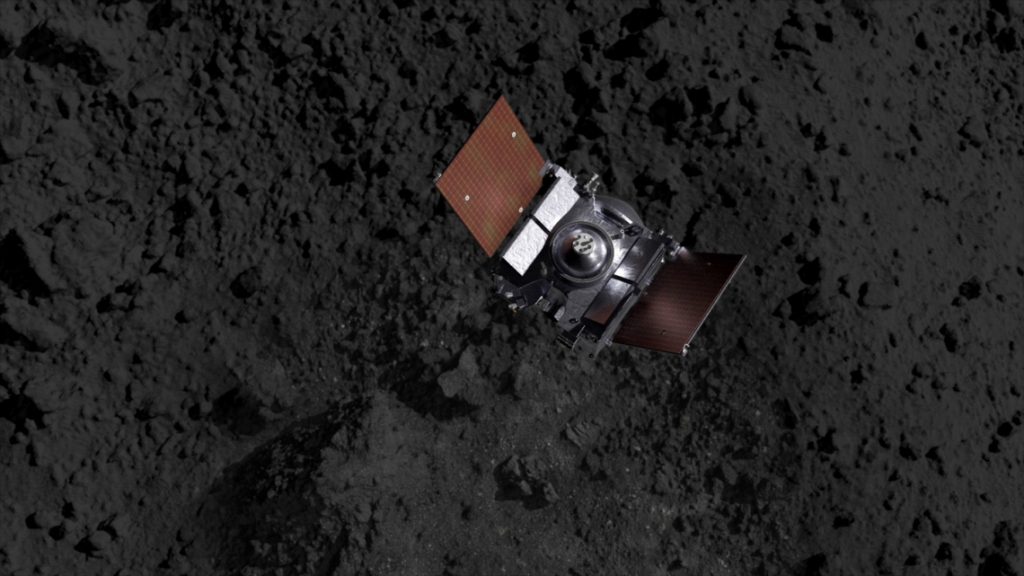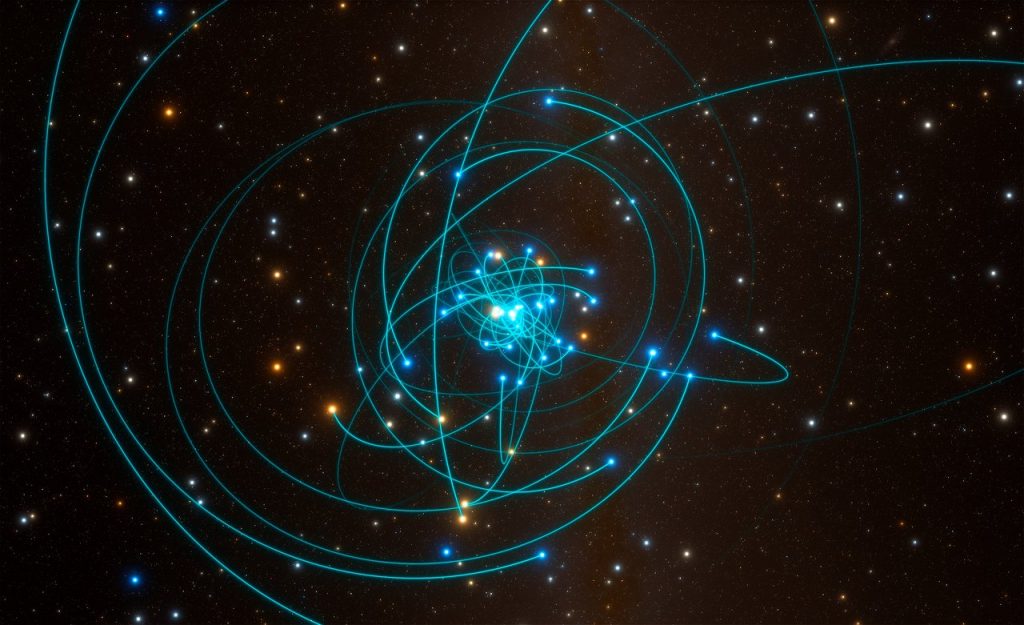Media
Transcript
In case you have been hiding under a rock, the OSIRIS-REx mission has successfully booped the rubble pile asteroid Bennu.

The mission began its maneuvering on Monday, changing its orbit in preparation to drop down to touch the surface. Final maneuvers began Tuesday, and we broadcast those instead of our normal episode. The mission’s target was a relatively smooth spot in the heart of Nightingale Crater, a depression near the northern pole of Bennu.
When originally considered as a sample site, Nightingale Crater was considered a bit too boulder-strewn, but it was quickly realized that pretty much everything on Bennu is boulder-strewn, and this region was the best available combination of science-rich and safe enough.
When the OSIRIS-REx mission was planned, no one knew this was going to turn out to be a rubble pile asteroid. It was assumed this 0.5 kilometers across asteroid would be rocky in places and smooth in places, like the similarly sized Itokawa asteroid. It was also planned that the spacecraft would be able to use its laser altimeter to safely drop to the surface and rise back up with not a lot of fancy image processing being required.
Bennu, however, opted to remind us the universe does not care what we think, anticipate, or plan. It is going to do things in its own way. For Bennu, this meant that there were no smooth places at all. There were only rocks on boulders on boulders with more rocks.

To safely make it to the surface and into the several-parking-spaces-across safe area, the mission had to match what its cameras were capturing with previously made maps of the region and maneuver by image matching rather than the simpler laser altimetry. Luckily, this spacecraft is working perfectly and was designed with the flexibility we didn’t know we’d need, and it was able to pull off all needed maneuvers perfectly. It spent a bit more than 10 seconds touching the surface with its touch-and-go sample acquisition mechanism (TAGSAM) instrument. During that time, it expelled a blast of nitrogen gas and pulled in the blasted up debris. The mission is hoping for a few grams of material but has the capacity to hold much more if much more happened to try to fit through the sample collector’s 2cm opening.
Over the weekend, the mission team will be rotating the spacecraft and will use the moment of inertia measurements to estimate how much material they have picked up. If they somehow came up empty, there are additional nitrogen canisters aboard, and they can go try up to two additional sites. They won’t return to Nightingale; after disturbing the surface, they can no longer use their image matching routines to find their way to the chosen site. There are, however, three backup sites already selected.
These sites represent the perfect combination of a bit less boulder-strewn and scientifically interesting. Identifying them required myriad researchers and several 1000 CosmoQuest volunteers who helped by marking rocks, measuring boulders, and tracing out craters. Our congratulations go to the mission team on the successful touch-and-go of their spacecraft, and our thanks go to all the citizen scientists who helped mark the oh-so-very-many rocks and boulders, with more rocks and more boulders, that litter this world.
Looking beyond one little rock and taking a fuller look at our galaxy, we have two new stories that look at the Milky Way’s structure.
Trying to figure out the shape of a galaxy we are inside is a bit challenging. Our view is impeded by gas and dust, and it is often hard to make a three-dimensional sense of our two-dimensional images. These struggles get even more difficult when we are trying to make sense of the structures within gas clouds – those streams and shells of compressed gas that trace out the disk of our Milky Way.
In a new paper in Astronomy & Astrophysics with first author JD Soler, researchers let computers take their turn in understanding our galaxy.

High-resolution Very Large Array (VLA) images of the distribution of hydrogen gas were fed into computer vision software that was coded to look for the slight overdensities that mark areas that have experienced shocks or been drawn together with gravity. The software was able to identify a 2000 lightyear long hydrogen lane through the disk of the galaxy that the team named Magdelena after the longest river in Colombia.
According to researcher Jonas Syed: [Magdalena] could be the largest known coherent object in the Milky Way. In recent years, astronomers have studied many molecular filaments, but Maggie seems to be purely atomic. Because of its fortunate position in the Milky Way, we are lucky to have been able to spot it.
In addition to this and many other expected structures laying parallel to the disk of the galaxy, the team also found bizarre structure pointing out of the galaxy. JD Soler explains: Like in the spinning pizza dough, we expected that most of the filaments would be parallel to the plane and stretched by the rotation. But when we found many vertical filaments around regions known for their high star formation activity, we knew we were onto something. Some process must have been blowing material off the galactic plane.
Continued analysis of these structures is going to allow the history of our galaxy to be observed through the echoing shockwaves of now-dead stars and regions of star formation. This research is just the start, and I can’t wait to see what else they find thanks to a little help from computer vision.
The next story comes to us from a collaboration that includes one of the most prolific researchers in astronomy: Avi Loeb. Working in collaboration with Giacomo Fragione, this pair looked at the motions of the stars orbiting closest to the supermassive black hole in the center of the Milky Way to see if they could use the stellar motions to get at the rotation rate of the black hole.

If you have a fast-rotating black hole (one going up to as fast as the speed of light), the twisting of space-time will affect the motions of objects around it, effectively scattering them more and more over time. This is like the effects of a hurricane on the motions of things trying to move near it; they simply get carried in new directions. If the black hole, however, isn’t rotating quickly, there is no scattering effect.
In looking at the S-stars orbiting the Milky Way, astronomers find two distinct populations orbiting in different planes. It’s believed these are stars that formed from two distinct star-forming regions and have since essentially migrated into rings of stars, as those a bit closer to the center of the galaxy orbited faster over the eons, and those a little further away orbited a bit slower.
Since both these rings of stars are still well defined, Fragione and Loeb calculate that our supermassive black hole, Sag A*, must be rotating no faster than 10% the speed of light.
This speed has consequences for how our galaxy can behave. With this low speed, infalling material won’t be whipped up into a quickly turning accretion disk that drives powerful magnetic fields that accelerate jets of material out of our galaxy. In fact, our system is likely to remain jet free through future interactions.
According to Fragione, this will also have an effect on future observations by the Event Horizon Telescope. Here, I’d like to admit, this quote is how I learned there are planned additional observing runs with the EHT. I can’t wait to see what the processed images eventually show, and I look forward to seeing this result of a slow rotating supermassive black hole confirmed. Until that happens, however, this has been the Daily Space.
Learn More
OSIRIS-REx Spacecraft Successfully Touches Asteroid
Milky Way’s Archaeological Record Written by Atomic Hydrogen
- MPIA press release
- “The History of Dynamics and Stellar Feedback Revealed by the HI Filamentary Structure in the Disk of the Milky Way,” J. D. Soler, H. Beuther, J. Syed, Y. Wang et al., 2020 Oct. 21, Astronomy & Astrophysics (preprint on arxiv.org)
- “The HI/OH/Recombination Line Survey of the Inner Milky Way (THOR): Data Release 2 and HI Overview,” Y. Wang, H. Beuther, M. R. Rugel, J. D. Soler et al., 2020 Feb. 12, Astronomy & Astrophysics (preprint on arxiv.org)
Monster in Middle of Milky Way Is…Spinning Slowly?
- Center for Astrophysics press release
- “An Upper Limit on the Spin of Sgr A* Based on Stellar Orbits in Its Vicinity,” Giacomo Fragione & Abraham Loeb, 2020 Oct. 1, Astrophysical Journal Letters (preprint on arxiv.org)
Credits
Written by Pamela Gay
Hosted by Pamela Gay
Audio and Video Editing by Ally Pelphrey
Content Editing by Beth Johnson
Intro and Outro music by Kevin MacLeod, https://incompetech.com/music/


 We record most shows live, on Twitch. Follow us today to get alerts when we go live.
We record most shows live, on Twitch. Follow us today to get alerts when we go live.